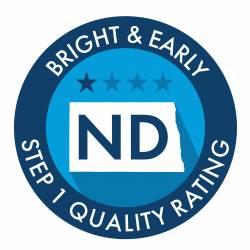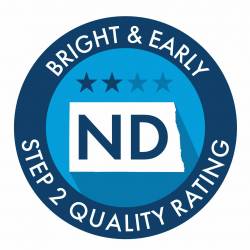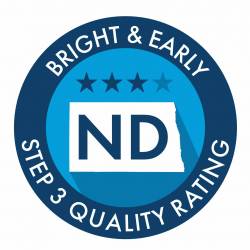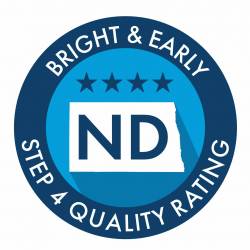
Bright & Early ND is North Dakota's Quality Rating and Improvement System (QRIS) designed to assess, improve, and communicate the level of quality of early childhood programs. Administered by Health and Human Services, Bright & Early ND serves as a key strategy for quality improvement under North Dakota law (NDCC 50-11.1)
Why Participate in Bright & Early ND?
Personalized Support for Success
When you participate in Bright & Early ND, you'll be paired with a dedicated team of professionals who will support you every step of the way. Together, you’ll identify your strengths and areas for growth, set goals that matter, create plans to achieve them, and track your progress. You'll never feel alone on this journey.
Professional Development Opportunities
Take advantage of various low- or no-cost training and networking opportunities. These opportunities promote continuous learning, strengthen staff qualifications, and help develop strong leadership within your program.
Access to Financial Incentives
Programs with a current Step 2, Step 3, or Step 4 Quality Rating may be eligible for financial incentives. These include additional payments for children receiving Child Care Assistance (CCAP) benefits, as well as Quality Improvement Grants to support your ongoing efforts in providing high-quality care.
Positive Outcomes for Children
By participating in Bright & Early ND, you're helping ensure all children have access to high-quality early childhood experiences—building the foundation they need to thrive in school and in life.
What is the Process?
The Bright & Early ND Quality Rating process is a journey not a destination. It’s designed to celebrate where your program is today, while providing the tools, coaching, and encouragement you need to keep moving forward. Whether you're just getting started or ready to take the next step, you’ll have support every step of the way.
Getting Started
To begin, your program must be licensed by Health and Human Services. Already licensed? You're automatically enrolled in Bright & Early ND with a Step 1 Quality Rating—and ready to move to the next step! Follow the process below to get started:
1. Submit Your Application
Go to the ND Early Childhood Hub and log in to your organization account. On the left-hand navigation menu, click on the "Quality Dashboard". From the Quality Dashboard, you can submit an application to pursue the next step.
Need help? Visit our frequently asked questions for step-by-step instructions.
2. Review Your Goals
Before making changes, take a moment to reflect on your current practices. This helps you understand what you’re already doing well and where you might want to grow. With support from your coach, you'll:
- Review the Bright & Early ND requirements for a Step 2, Step 3, and Step 4 Quality Rating.
- Consider how your program currently meets—or could meet—these standards.
- Identify areas of strength and opportunities for growth.
- Set clear, meaningful, and realistic goals tailored to your program.
Remember, you don't have to do everything at once. Focus on what matters most to your children, staff, and families.
3. Make a Plan
Now it’s time to turn your goals into action with a Quality Improvement Plan. This simple roadmap includes:
- S.M.A.R.T. goals that target areas for growth.
- Clear action items that break down how changes will be made.
- Resources or training needed to support those changes.
- A realistic timeline for reaching your goals.
Your coach will work alongside you to ensure your plan is achievable and customized to your program.
4. Create Change
This is where you put your Quality Improvement Plan into motion! This might include:
- Redesigning your space.
- Updating materials, toys, or curriculum.
- Participating in training or peer learning communities.
- Strengthening interactions amongst teachers and children.
- Finding new ways to engage families.
Change happens one step at a time, and your coach will support you throughout the process.
5. Submit For Review
Once you feel confident that your program meets the requirements, submit your evidence for review. This includes:
- Reviewing and completing each indicator in your Quality Standards Inventory.
- Ensuring your evidence demonstrates how your program meets each indicator.
- Submitting your completed Quality Standards Inventory for validation.
A validation specialist will review your submission and provide feedback. If approved, you’ll receive your new Bright & Early ND Quality Rating!
6. Celebrate Your Success
You did it! When you achieve your Bright & Early ND Quality Rating, you’ll receive:
- A certificate and promotional materials.
- Public recognition on the Health and Human Services website.
- Access to financial incentives.
- A stronger foundation for your children, staff, and families.
And remember—this is just one milestone in your journey. When you're ready, the next step awaits!
Bright & Early ND Quality Standards
The Bright & Early ND Quality Standards are a set of clear, research-informed criteria used to measure and support quality in early childhood programs. These standards go beyond rating—they help programs reflect on their current practices, set meaningful goals, and grow over time.
While not exhaustive, the standards provide a shared framework for recognizing, supporting, and strengthening quality across North Dakota.
Programs can voluntarily progress through four levels, or steps, of quality. Each step builds upon the previous one, and programs must fully meet the criteria of each step before advancing. This step-by-step approach supports meaningful quality improvement at a pace that works for each program.
Step 1: Health and Safety

A healthy and safe environment is the foundation of high-quality early childhood experiences. When children are healthy and feel safe, they are better able to explore, build relationships, and engage in meaningful learning.
Programs that meet this standard:
- Are licensed by Health and Human Services and meet basic requirements for space, safety, cleanliness, staff qualifications, and staff-to-child ratios.
- Receive regular monitoring visits from a Licensing Specialist who ensure that licensing regulations are being followed through on-site visits, record reviews, and observations.
- Promote physical safety by actively preventing injuries, while also supporting safe, age-appropriate risk-taking that encourages exploration and development.
All licensed early childhood programs in North Dakota are automatically enrolled in Bright & Early ND with a Step 1 Quality Rating.
Step 2: Space and Materials

Building on a foundation of health and safety, Step 2 focuses on creating environments that inspire hands-on exploration, reflect children’s interests, and promote independence. When children are in intentionally designed environments, they are more likely to engage deeply, think critically, and develop a strong sense of self.
Programs that meet this standard:
- Continue to meet the requirements of Step 1.
- Design indoor and outdoor environments that are organized, welcoming, and offer a variety of age-appropriate materials that support learning through exploration.
- Use children's interests and developmental stages to guide the selection and rotation of materials, creating spaces that promote engagement, creativity, and social interaction.
- Regularly reflect on and adjust the environment to ensure inclusivity and support for each child’s development and learning.
Step 3: Activities and Experiences

Building on safe, supportive environments, Step 3 emphasizes intentional, meaningful activities that build on each child's strengths and developmental progress. When learning experiences are planned with purpose and aligned with developmental goals, children are more likely to thrive—academically, socially, and emotionally.
Programs that meet this standard:
- Continue to meet the requirements of Step 1 and Step 2.
- Use a curriculum aligned with the North Dakota Early Learning Standards: Birth to Kindergarten to plan activities and guide teaching practices.
- Conduct observation-based assessments to ensure children are making progress toward developmental milestones and goals.
Step 4: Relationships and Interactions

At the highest level of quality, programs cultivate warm, supportive environments where they feel safe to take risks, explore new ideas, and build strong relationships. Positive, responsive interactions between children and caregivers lay the foundation for lifelong learning, social development, and emotional well-being.
Programs that meet this standard:
- Continue to meet the requirements of Steps 1-3.
- Build caring, respectful relationships with each child and encourage positive connections among children.
- Consider children’s interests, motivations, and perspectives in daily routines and activities.
- Support children’s thinking and language development through thoughtful, engaging conversations.
Want More Information? Stay Connected
Stay up to date with the latest information and resources by subscribing to the Child Care Connections newsletter, delivered quarterly by Health and Human Services.
